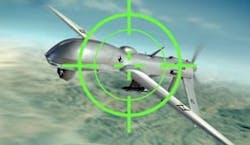Army asks Lockheed Martin to develop UAV high-power microwave weapons to destroy or disable enemy drones
Officials of the Adelphi contracting division of the Army Contracting Command at Aberdeen Proving Ground, Md., announced plans Friday to negotiate sole-source with the Lockheed Martin Missiles and Fire Control division in Grand Prairie, Texas, on an HPM UAV weapons project.
Lockheed Martin engineers will develop high-powered-microwave airborne counter unmanned aircraft systems (CUAS), including the necessary development, integration, and support necessary to field HPM weapons-equipped UAVs.
Specifically, Army leaders want Lockheed Martin to develop HPM weapons and other kinds of UAV payloads able to disable or destroy adversary UAVs. Weapons payloads for UAVs that are under consideration include explosives, nets, entanglers, streamers, and high-powered-microwave systems.
High-power microwaves represent a class of non-lethal weapons designed to destroy or disable enemy electronic systems with jolts of powerful electrical energy. It can fry electronics in much the same way as the electromagnetic pulse (EMP) from a nuclear detonation can disrupt electronics.
Related: Air Force looking for power sources and antennas for future high-power microwave weapons
High-power microwaves could destroy or disrupt an enemy UAV by destroying its antennas, data links, guidance, and communications subsystems, as well as blinding the enemy UAV's RF and electro-optical sensors.
Army officials say Lockheed Martin is the only responsible source able to develop HPM-based UAV weapons payloads to the Army's specifications.
Any other companies with enabling technologies sufficient to meet Army needs may submit a capability statement, proposal, or quotation no later than 16 Aug. 2018. Companies interested should email the Army's Elaine Modl at [email protected], or Lindsay Decker at [email protected].
More information is online at https://www.fbo.gov/notices/38c66baa9b53a9d12eb840eaebe56955.
Ready to make a purchase? Search the Intelligent Aerospace Buyer's Guide for companies, new products, press releases, and videos
